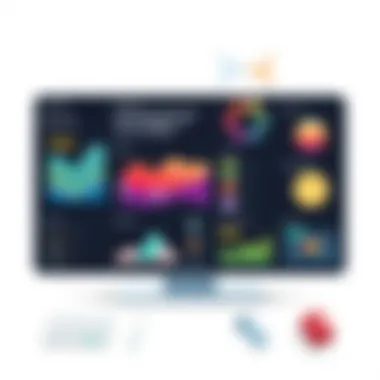Core Principles of UX Design by InVision


App Overview
User experience (UX) design is a pivotal aspect of any application, shaping how users interact with technology. InVision stands out as a prime resource for this, offering actionable insights that bridge theory and practice. At its core, InVision emphasizes principles that lead to compelling interfaces and heightened user satisfaction.
Main Features
The platform focuses on several key principles:
- Empathy in design: Understanding users’ emotions and actions.
- Iterative testing: Continual refinement based on user feedback.
- Design thinking: A solution-focused approach that encourages innovation.
By integrating these features, it creates an environment where designers learn to build experiences that resonate with users on multiple levels. The focus is not merely on aesthetics, but on crafting meaningful interactions that invite users to engage genuinely.
Step-by-Step Walkthrough
To harness the power of InVision, users need to navigate its features effectively. Here’s how one might go about using the platform:
- Creating an Account: Begin by signing up at InVision if you haven’t already done so. The process is straightforward and quick.
- Setting Up a Project: Once logged in, select the option to create a new project. It may prompt you to choose a template or start from scratch. Both options have their merits.
- Prototyping: Use the prototyping tool to sketch out your ideas. It allows for the creation of clickable mockups that can mimic the end-user experience.
- Collaboration: Share your project with stakeholders for feedback. InVision’s collaboration tools provide a platform for comments and discussions right within the project space.
- Iterate and Refine: After gathering feedback, return to your design and make adjustments based on insights garnered from your team or user testing.
This circular approach sustains project momentum and encourages continuous improvement while naturally laying the groundwork for refining user experiences.
"Design is not just what it looks like and feels like. Design is how it works." – Steve Jobs
Tips and Tricks
Maximizing the utility of InVision involves digging into some of its lesser-known features:
- Keyboard shortcuts can speed up navigation within the app. For example, pressing P quickly brings up the prototype mode.
- Comment threads are invaluable for collaborative feedback, keeping discussions and suggestions organized.
- Explore timeline features that record changes, making it easy to revert to previous designs if needed.
These insights can often make the difference in streamlining workflow.
Common Issues and Troubleshooting
While navigating InVision, you might face hurdles that are common across user experience platforms. Here are a few:
- Loading issues: If projects take too long to load, ensure you are operating on a stable internet connection. Sometimes, simply refreshing the page resolves the glitch.
- Collaboration hiccups: If team members can’t access shared projects, check permission settings. It’s a common oversight that can lead to confusion.
- Feedback delays: In the case that comments and suggestions aren’t showing up, ensure the project is publicly shared or that users are logged in with the right credentials.
By keeping these troubleshooting techniques in mind, users can navigate potential bumps in the road with greater ease.
App Comparison
For those considering their options, it’s helpful to contrast InVision with similar tools like Adobe XD and Sketch.
- InVision excels in collaboration and prototyping, making it ideal for teams seeking iterative feedback.
- Adobe XD offers robust design capabilities with a strong focus on vector graphics.
- Sketch thrives in streamlined interface design but lacks the collaborative aspect that InVision prioritizes.
Each of these tools has unique selling points, but InVision’s emphasis on user feedback and its community-oriented platform sets it apart in the competitive landscape of UX design.
In fusion of its principles, insightful features, and user-focused design, InVision emerges not just as a tool, but a launching pad for creating meaningful user experiences.
Understanding User Experience Design
Understanding user experience (UX) design is crucial for anyone involved in creating applications or digital interfaces. This section serves as the foundation for appreciating how design affects user interaction, satisfaction, and overall functionality. Essentially, UX design is not just about making things look good; it’s a structured approach to making products that are easy and enjoyable to use.
Defining User Experience
User experience refers to the overall feeling a person has when interacting with a system, which includes all aspects of the interaction. It encompasses everything from how intuitive the interface is, how quickly users can accomplish their tasks, to how they feel emotionally during the interaction. To put it plainly, if the user feels frustrated or confused while using an app, then you have a poor user experience on your hands.
- Usability: An element often highlighted in defining UX, it points to how effectively users can achieve their goals. A user-friendly product can mean the difference between a happy user and an angry one.
- Accessibility: This is another vital layer; UX also intertwines with accessibility, ensuring that everyone, including those with disabilities, can effectively use the product. People mustn’t feel like they are hitting a brick wall when trying to navigate a digital space.
- Emotional Response: Positive feelings lead to customer loyalty. When users engage with a product that resonates with their needs or desires, this emotional bond can reflect back into user retention rates and overall satisfaction.
Importance of UX in App Development
In the competitive world of app development, UX design is often what sets a successful application apart from the rest. The benefits of a well-thought-out user experience cannot be overstated:
- Increased Engagement: A solid UX drives users to keep coming back. If users find your app engaging and easy to use, they’re more likely to not only stick around but recommend it as well.
- Higher Conversion Rates: When an app offers a clear and concise user journey, it leads to higher conversion rates. Users are more likely to complete actions, be it signing up or making a purchase, if the process is smooth.
- Reduced Development Costs in the Long Run: Investing time in UX design upfront may seem like an extra step, but it can save a ton of money down the line by reducing the need for significant redesigns and minimizing user complaints.
- Competitive Advantage: As the saying goes, ‘the cream rises to the top.’ A product or app with an exceptional user experience will typically thrive in a crowded market.
"Design is not just what it looks like and feels like. Design is how it works." – Steve Jobs
Understanding the fundamentals of user experience design lays the groundwork for creating intuitive interfaces that resonate with users and keep them engaged longer than average. It’s clear that a strong emphasis on UX not only enhances usability but also contributes to overall success in the digital realm.
Core Principles of UX Design
Understanding the core principles of UX design is not merely academic; it’s fundamental to shaping how users interact with apps. Each principle acts as a building block, guiding designers toward creating experiences that are not only functional but also enjoyable. Focusing on these principles boosts overall user satisfaction and fosters a sense of trust between users and the product.
Key aspects of UX principles include usability, accessibility, and a focus on user needs. By adhering to these tenets, designers can create intuitive interfaces that resonate with users. Additionally, well-considered UX reduces support costs and boosts retention rates, ultimately leading to a more successful product in the competitive app landscape.
User-Centered Design
User-Centered Design (UCD) is one of the cornerstones of effective UX. It emphasizes placing the user at the very heart of the design process. In practice, this means involving real users in the development stage, appreciating their preferences and pain points. Rather than guessing what users want, a UCD approach entails conducting research—surveys, interviews, and field studies—to gather insights.
The beauty of UCD lies in its iterative nature. As new findings emerge, designs can be continuously refined, ensuring they address the actual needs of users. UCD not only yields products that are easier to use but also ones that can be adapted to meet evolving user expectations. In this fast-paced environment, designers ought to develop a flexible mindset, ready to pivot based on user feedback and behaviors.


Consistency in Design
Consistency serves as the scaffolding of design. When elements behave in predictable ways across platforms, users find comfort and familiarity. This does not mean a lack of creativity; rather, it allows for innovation within familiar boundaries, thereby reducing the learning curve for users. A consistent design language—encompassing color palettes, fonts, and layout—creates a unified experience that enhances brand recognition.
In real-world application, imagine navigating through different sections of an app with varying button styles or unexpected menu configurations. Such discrepancies can confuse users, leading them to abandon a task or, worse, the app altogether. By maintaining consistency, designers help users reach their goals efficiently, solidifying their overall satisfaction with the product.
Feedback Mechanisms
Feedback mechanisms are vital for providing users with clear indicators of their actions. Without feedback, a user is like a ship without a compass, unsure of whether their commands are effective or if the system has processed their inputs. Effective feedback can take many forms, such as visual changes, auditory notifications, or haptic vibrations.
For instance, a simple color change or a loading spinner can reassure users that their request is being processed. Conversely, users should also be warned of errors in a clear yet constructive manner. Striking a balance in feedback is crucial. Too much can overwhelm, while too little may frustrate. Designers should be attentive, harnessing feedback not just as a reactive tool but as an integral part of the user journey, influencing how they interact with the system.
“User experience is not just about what users do, but how they feel while doing it.”
By focusing on these core principles, designers can create comprehensive and engaging user experiences that encourage sustained interaction and foster loyalty.
The Role of Design Thinking
Design thinking plays a crucial role in user experience (UX) design by promoting a human-centered approach. Its essence lies in bridging the gap between the user's needs and the practical application of design. This methodology serves as a compass, guiding designers in crafting solutions that are not only functional but also resonant with users. The beauty of design thinking is that it embraces a variety of disciplines, nurturing creativity and collaboration throughout the design process.
When it comes to implementing design thinking, there are several elements worth pondering:
- Empathy: Understanding the user’s feelings, desires, and challenges is foundational. It ensures that the solutions created address real, human needs rather than assumptions.
- Iteration: Design thinking encourages frequent testing and refinement of ideas. This cyclical process fosters innovation and ensures that solutions remain relevant and effective over time.
- Collaboration: Successful design thinking thrives on teamwork. Involving stakeholders from various backgrounds can yield richer insights and more comprehensive solutions.
Design thinking can also lead to tangible benefits:
- Increased User Satisfaction: By centering the process around users, designers create products that genuinely resonate with them, enhancing overall satisfaction.
- Fostering Innovation: The iterative nature allows for experimenting with ideas, which can result in breakthroughs that address gaps in the market.
- Adaptability: As design thinking encourages feedback, it allows designs to evolve in response to user input, thus minimizing missteps.
Considering these points, it becomes clear that design thinking is not just a trendy buzzword—it is a formidable tool in the UX designer’s arsenal, essential for creating interfaces that engage users meaningfully.
Empathy in Design
In the realm of UX, empathy is often heralded as the golden ticket. It goes beyond mere understanding; it’s about stepping into the shoes of users, comprehending their emotions, and identifying the contexts in which they interact with an application. This depth of insight forms the backbone of successful UX design.
To delve deeper into empathy, consider the following:
- User Journals: Having users document their experiences can reveal pain points and improve refinement.
- Role-Playing: Stepping into the user’s shoes during workshops helps team members to identify with their frustrations and expectations.
By embedding empathy into the design process, solutions become more intuitive and user-friendly. Designers can anticipate user needs, often before they are articulated, which creates a smoother navigational experience.
Defining Problems through Insights
Defining the right problem is crucial. A well-defined problem can lead to targeted solutions, while a vague definition can send a team on a wild goose chase. Insights gained from user research often illuminate these problems, pinpointing areas that need addressing.
Here’s how to hone in on defining problems effectively:
- Data Interpretation: Analyze qualitative and quantitative data from surveys and usability tests. Understanding trends or recurring issues can steer efforts in the right direction.
- Synthesizing Information: Create affinity diagrams from user interviews, helping to group insights into themes that reveal core issues.
By approaching the design process with a clear problem statement, teams are equipped to develop effective solutions that resonate with real user needs.
Ideation and Innovation
When brainstorming solutions, ideation can become a fertile ground for innovation. This stage encourages creativity and open-minded exploration, allowing teams to generate diverse ideas without restrictions.
Methods to stimulate ideation include:
- Brainstorming Sessions: Engaging in planned group discussions where silos are broken to allow free flow of ideas.
- Mind Mapping: Visually organizing thoughts can spark connections between concepts that may not have been apparent.
- Sketching: Quickly scribbling ideas can ease the pressure of perfection, encouraging more representatives to participate.
The beauty of ideation is that it is not confined to a single outcome. By encouraging a broad range of ideas, teams can explore various avenues and identify the most promising paths forward. Remember, great ideas often come from unexpected places, and fostering an environment where anything is possible can unleash true innovation.
In summary, design thinking serves as a pivotal framework in UX design. By integrating empathy, defining problems through insights, and nurturing ideation, designers can create experiences that not only meet user expectations but also inspire long-term engagement.
Creating Effective Prototypes
Prototyping stands as a cornerstone in the realm of user experience design. It isn’t just about putting together a visual representation of ideas; it's about constructing a tangible form for your concepts. Effective prototypes serve multiple purposes, ultimately helping designers to explore and validate their assumptions early in the design process. By allowing stakeholders and users to interact with a preliminary version of the product, prototypes can help identify usability issues before development begins. This saves time, resources, and iteration later on.
Prototyping encourages exploration and helps adjust designs based on user feedback, ensuring that efforts are not wasted on the wrong direction. When you create a prototype, you are painting the fast-track picture of what the final product could be while allowing room for potential changes. Here, we’ll take a look at the three primary aspects of prototyping: types, tools, and the significance of validating ideas.
Types of Prototyping
In the world of design, not all prototypes are cut from the same cloth. There are several types that serve varying purposes:
- Low-Fidelity Prototypes: These are often quick sketches or paper models. They provide a rough visual concept, allowing developers to gauge early thoughts without getting bogged down in aesthetics.
- Medium-Fidelity Prototypes: Often digital wireframes or mockups, these prototypes give a bit more detail and functionality, offering clickable elements that can simulate user interactions.
- High-Fidelity Prototypes: These are close to the final product and include comprehensive visual aspects and detailed interactions. Users can almost experience the product as they would in real life.
Each type has its place and can be used at various stages of the design process. Low-fidelity works well in brainstorming sessions, while high-fidelity prototypes are better for final user testing before launch.
Tools for Prototyping
Choosing the right tools to create your prototypes can make all the difference. Each tool offers unique features tailored to specific needs. Some popular options include:


- Figma: A collaborative web-based design tool that shines in team environments.
- Adobe XD: Great for creating high-fidelity prototypes with robust sharing capabilities.
- InVision: Many professionals favor InVision for its user-friendly interface and seamless transition from design to prototype.
- Sketch: Ideal for those focused solely on digital products, offering a robust design solution.
These tools can streamline the prototyping process, allowing for rapid iteration and feedback. They make the back-and-forth between designers and stakeholders more effective, ultimately resulting in a more user-centric outcome.
Validating Ideas through Prototyping
Prototyping isn't merely a stage to create a visual representation; it's a powerful method of validating ideas. Engaging users with prototypes allows for real-world feedback, leading to improved design decisions. Through direct interaction, you can assess whether design choices resonate with users or dive deeper into why they're missing the mark. Here’s how to effectively validate your ideas:
- User Testing: Bring your prototype to actual users. Observe their interactions and gather feedback.
- Surveys and Interviews: Post-interaction surveys can deliver insights into user satisfaction and usability issues.
- Iterate Based on Feedback: Adapt your design based on the feedback received. This means not being overly attached to your initial concepts.
"The real voyage of discovery consists not in seeking new landscapes, but in having new eyes." – Marcel Proust
Effective prototyping offers a compromise between the dream and reality of digital product design. It's about creating pathways for innovative ideas to flourish while ensuring that what is developed aligns with user needs. Through well-planned prototypes, developers craft pathways to engage effectively, allowing for a smoother transition from vision to a fully realized product.
Iterative Design and Testing
In the realm of user experience design, iterative design and testing stand as pivotal practices that propel projects towards success. This dynamic process allows designers and developers to refine their work through cycles of testing and feedback. Rather than a linear approach that merely seeks to achieve a final product, iterative design embraces an ongoing conversation between the design team and the end-users. This dialogue not only identifies areas of improvement but also ensures that the end result resonates with the actual needs of the users.
The Importance of Iteration
Iteration is crucial in UX design for several reasons. First off, it significantly reduces the risk associated with launching a product. By continually refining the design, teams can address issues before they become larger problems. The result? More user-friendly interfaces and minimized frustration.
Additionally, iteration fosters a culture of openness and adaptability. When teams commit to repeated cycles of design, prototype, and test, they cultivate an environment where feedback is not just welcomed but actively sought. This approach encourages innovation, as ideas can be rapidly prototyped and tested with real users. The key here is that each iteration offers builders and creators a fresh perspective aimed at honing the overall experience. The vital message is clear: it’s not about making one perfect design; it's about constant improvement.
User Testing Methods
Understanding how users interact with a product is foundational. Various user testing methods contribute to this understanding, and choosing the right method is crucial to gleaning actionable insights. Among the common techniques are:
- A/B Testing: This method allows designers to compare two versions of a design to determine which performs better.
- Usability Testing: In this method, real users perform tasks with the design while observers take notes on their experience.
- Remote Testing: This offers flexibility, allowing users to test the product from their environment, providing a more genuine interaction.
Designers should use a blend of these methods tailored to their specific project goals. Often, times these methods can unveil surprising insights that can redefine a project trajectory.
Gathering and Analyzing Feedback
Feedback is the lifeblood of the iterative design process. Effectively gathering and analyzing feedback requires a strategic approach. Here’s how to do it:
- Encourage Honest Communication: Make it easy for users to voice their opinions without fear of repercussions. Surveys or follow-up emails after usability tests can be powerful.
- Use Analytics Tools: Platforms like Google Analytics or Hotjar can provide deep insights into user behavior. Tracking page views, bounce rates, and time on site can all inform design decisions.
- Focus on Specific Questions: Instead of general inquiries, target questions that address particular features or elements. For example, "What did you think about the navigation?" can yield more useful responses than asking, "What did you think of the app?"
Remember, effective feedback gathering is a continuous cycle and should be treated as such. The more input you collect, the more you can refine the design to meet user needs. In the end, gathering accurate feedback is crucial for making informed design choices that lead to a better user experience.
Implementing Accessibility in UX
Accessibility in UX design is not just a nicety; it’s a necessity. In a world where technology permeates our daily lives, creating experiences that everyone can engage with is paramount. This section digs into why accessibility matters and how integrating specific elements can lead to more inclusive applications that benefit all users.
Understanding Accessibility Principles
At the core of accessibility is the principle of inclusivity. Accessibility ensures that individuals, regardless of their abilities or disabilities, can navigate, understand, and use applications. This starts with understanding the different types of disabilities, which can be broadly categorized into visual, auditory, physical, speech, cognitive, and neurological.
The essence of accessibility is in the Web Content Accessibility Guidelines (WCAG). These guidelines offer a robust framework, outlined under four primary principles:
- Perceivable: Information must be presented in ways users can perceive, whether through vision, hearing, or touch.
- Operable: Users must be able to navigate and interact with all elements smoothly through various means, including keyboard navigation for those with motor disabilities.
- Understandable: The interface must be clear and straightforward to facilitate user comprehension, avoiding jargon or overly complex language.
- Robust: Content must be compatible with current and future user agents, including assistive technologies.
By adhering to these principles, designers can create experiences that empower a diverse user base.
Inclusive Design Strategies
When you think about inclusive design, it’s about more than just following rules; it’s about creating a mindset where every user feels considered. Here are some strategies that can help foster an inclusive design approach:
- User Testing with Diverse Groups: Engage with individuals from various backgrounds, including those with disabilities, during the testing phase. This firsthand feedback can shed light on accessibility gaps that you may not see.
- Flexible Design Components: Utilize modular design elements that can adapt depending on user needs. For instance, enable adjustable font sizes and colors that can be customized according to the user’s preference.
- Clear Labeling and Instructions: Make sure that all buttons, images, and controls are properly labeled. This assists screen reader users and enhances clarity for all users.
- Alt Text for Images: Always provide descriptive alt text for images. This assists visually impaired users who rely on screen readers to understand what is happening in the visual content.
- Keyboard Navigation: Ensure your app can be fully navigated using a keyboard. Many users with physical disabilities rely on keyboard shortcuts instead of a mouse.
- Contrast and Color Considerations: Use high contrast ratios to ensure readability. Remember that not every user perceives color in the same way; avoid using color as the sole means of conveying important information.
Implementing these strategies not only creates a better experience for users with disabilities but also enhances usability for everyone. After all, a design that is accessible tends to be straightforward and well-thought-out, leading to broader user satisfaction.
"Accessibility means ensuring that your design is not only usable but also welcoming to everyone."
By focusing on accessibility in UX design, we open doors for all users, allowing them to enjoy the full spectrum of digital experiences without barriers. App developers and designers who adopt these practices become not only innovators of technology but champions of inclusivity.
Crafting Visual Hierarchy
In the realm of user experience design, crafting visual hierarchy serves as a cornerstone for intuitive and engaging interfaces. Visual hierarchy governs the arrangement and presentation of elements that guide users through content, ensuring that they can quickly and efficiently find the information they need. Without a well-structured hierarchy, users can become disoriented, leading to frustration and disengagement. Therefore, understanding and applying visual hierarchy is paramount for effective UX design.
The key elements that contribute to visual hierarchy encompass size, color, contrast, whitespace, and typography. Each element plays a distinct role:
- Size: Larger elements naturally draw attention first. For instance, a prominent call-to-action button should stand out against its surroundings to elicit user interaction.
- Color: Colors can evoke emotions and convey meaning. A strategically used color palette can highlight important features while maintaining aesthetic harmony. For example, red signals urgency whereas blue might suggest trust.
- Contrast: High contrast between text and background makes information more legible. Designing with contrast in mind can emphasize key points and guide users smoothly through the content.
- Whitespace: Often overlooked, whitespace enhances readability by providing breathing room around elements. A cluttered interface can easily overwhelm users, while generous spacing fosters a sense of calm and allows for easier navigation.
- Typography: The style and arrangement of text influence readability and perception. Using different font sizes, weights, and styles can classify content tiers and direct focus intentionally.
The benefits of a well-crafted visual hierarchy are manifold. Primarily, it aids in user navigation, allowing users to skim and scan content effectively. By drawing attention to significant elements, designers can lead users towards desired actions, such as signing up, making a purchase, or exploring further offerings. Additionally, a cohesive visual hierarchy enhances overall aesthetic appeal, reinforcing brand identity through consistent design language.
However, several considerations must be kept in mind while implementing visual hierarchies:


- Be mindful of accessibility to ensure that all users, regardless of ability, can engage with your content.
- Strive for balance; overly complex or cluttered layouts can dilute the message you wish to convey.
"Visual hierarchy is not just about making things pretty; it's about guiding users effectively toward what matters most."
In short, crafting visual hierarchy is an art that requires careful consideration and precise execution. By paying attention to the fundamental elements of design, developers and designers can create interfaces that not only look appealing but also function seamlessly, serving the primary goal of enhancing user experience.
Elements of Design
An effective visual hierarchy hinges considerably on well-thought-out elements of design. These elements work in concert to establish a layout that feels both natural and logical to the user. Each element contributes uniquely:
- Line: Lines can guide the viewer’s eye and create divisions in spaces. They can be used to connect or separate elements and indicate relationships between them.
- Shape: Different shapes evoke different reactions; for instance, circles are often perceived as softer and friendlier than harder shapes like squares and triangles, which are perceived as strong or reliable.
- Texture: Texture can add depth and interest. A tactile quality can help to enhance the user experience by providing visual cues that suggest how to interact with elements.
- Color Theory: Understanding the impact of colors can enrich the emotional landscape of the design. A thoughtful color scheme can reinforce messaging and engender positive associations with the product.
Utilizing a thoughtful mix of these design elements will not only solidify the visual hierarchy but also contribute to a more holistic and immersive experience for the user.
Utilizing Space and Layout
Proper use of space is crucial in establishing an effective visual hierarchy. The layout of a design sets the stage for how information is presented. Utilizing space effectively can transform a chaotic interface into a polished, approachable product.
- Grid Systems: Using a grid simplifies the alignment of elements, making it easier to create consistent layouts that are pleasing to the eye.
- Alignment: Proper alignment creates order, enabling users to engage with content without cognitive dissonance. Elements that are anchored neatly promote flow and direction.
- Proximity: Strategic placement of related items in close proximity helps visually signify relationships among them, thus enhancing comprehension.
Streamlining layout with ample spacing allows for efficient scanning and helps in emphasizing key features. In mobile applications, minimizing visual clutter by prioritizing essential elements improves usability.
In summary, thoughtful crafting of visual hierarchy through the balance of elements and layout considerations can profoundly impact user satisfaction. By focusing on these principles, designers can create user interfaces that are not only functional but also resonate deeply with users.
User Research Methodologies
User research methodologies play a paramount role in creating user-centric designs. They are the backbone of the design process, offering insights into users' needs, behaviors, and motivations. This is crucial, especially in a world where digital experiences either make or break a product's success. By engaging in thorough research, designers can ensure that what they create not only resonates with users but also meets their expectations effectively.
The value of user research cannot be overstated. It provides a wealth of information that aids in understanding users on a deeper level. With insights gathered through various methodologies, designers can create more informed, targeted solutions. Here are some specific elements and considerations regarding the importance of user research:
- Empathy Building: It enables designers to step into the users’ shoes. For instance, knowing what frustrates them helps in tailoring solutions that resolve their pain points effectively.
- Validating Ideas: Research offers a reality check for concepts. Before spending resources on development, validating ideas with real users can save time and costs.
- Market Understanding: Through user research, one can gauge market trends and user preferences. This is essential for not just meeting user needs, but exceeding them.
To successfully compile user insights, designers typically deploy several methodologies. Let’s delve into how to effectively use these techniques:
Compiling User Persona
Creating user personas is foundational in the contextual research process. These aren’t just demographic profiles; they're dynamic characters that embody the traits and behaviors of actual users. To compile effective user personas, designers start by gathering quantitative and qualitative data through various means like surveys and interviews. A persona typically includes:
- Name and job title
- Background and demographics
- Motivation and goals
- Challenges or pain points
Once the persona is defined, it's a matter of regularly referring back to this character during the design phases, ensuring that decisions made reflect the user’s needs and realities. Imagining how "Sara," a busy mom who values efficiency, might interact with an app will guide design choices toward creating a more user-friendly experience.
Surveys and Interviews
Surveys and interviews are two core techniques for collecting user feedback directly. Surveys allow one to gather insights from a larger group. They can be distributed online, providing a wide reach and the ability to analyze data in a structured manner. However, too many questions may overwhelm respondents. Crafting clear, straightforward questions is key here. Effective examples might include asking users:
- What features do you value the most?
- How often do you use similar apps?
Interviews, on the other hand, dive deeper. They offer an opportunity for richer interaction, enabling designers to explore users' thoughts and feelings about their experiences. This method often leads to discovering insights that surveys might miss. Depending on how the conversation flows, follow-up questions can help unpack complex emotions tied to user experiences, revealing a wealth of information.
Observational Studies
Observational studies take user research a step further by watching how people interact with a product in real-time. This method provides context that surveys and interviews might not capture. Observational research can expose unexpected user behaviors and interactions, which can be vital in adjusting design approaches. Key aspects to consider:
- Participants should represent a cross-section of intended users to gain diverse insights.
- The environment should be natural, where users are comfortably using the product without external pressures.
A typical observation might reveal that users take longer to navigate through an app's menu than anticipated, prompting a reevaluation of the design layout to promote ease of use.
Understanding your user isn’t a one-time project; it’s an ongoing process that fuels continuous improvement.
Next Steps in UX Design
As the landscape of technology continues to evolve at a breakneck pace, understanding how to navigate the next steps in UX design is critical for those seeking success in app development. This section highlights not just the relevance of continual growth but also the necessity of staying abreast with the current trends that shape user experiences.
Continuous Learning and Growth
In the fast-paced world of UX design, stagnant knowledge can quickly become obsolete. Hence, continuous learning is more than just a buzzword; it’s a survival strategy. Much like a tree that grows stronger and spreads its branches to reach sunlight, a UX designer must continually expand their skill set to thrive.
Engaging in online courses, attending workshops, and participating in UX communities are valuable steps that designers should embrace. For instance, platforms like Coursera or LinkedIn Learning offer various courses that range from basic design principles to advanced techniques in human-centered design. Likewise, bootcamps focused on UX offer intensive training and real-world projects that can significantly enhance one’s portfolio.
Additionally, learning doesn’t only happen in a formal setting. Networking with fellow professionals can lead to insightful conversations and fresh perspectives. Consider forums or discussion groups on platforms such as Reddit or Facebook, where members share experiences, challenges, and solutions concerning user experience.
“The only source of knowledge is experience.” – Albert Einstein
Overall, the shift towards a mindset of growth allows designers to adapt to users' needs as they morph over time. Investing in yourself will not only enhance your design skills but also keep your designs relevant to modern trends and technologies.
Staying Informed about Trends
Keeping an eye on emerging trends in UX design is akin to having a compass that guides you through the vast sea of design choices and preferences. In an age where user preferences shift overnight, being aware of what’s trending can make all the difference.
- Research Current Trends: Regularly visit blogs, podcasts, and websites dedicated to UX. Websites like Smashing Magazine or Nielsen Norman Group offer invaluable articles and research that can inform and inspire.
- Follow Industry Leaders: Professionals and thought leaders often share their insights on social media platforms like Twitter and LinkedIn. Following them can expose you to avant-garde ideas before they become mainstream.
- Engage with UX Communities: Participating in online and local UX meetups can expose you to firsthand accounts of what tools and techniques are gaining traction. Check out Eventbrite or Meetup.com to find pertinent gatherings near you.
As the design industry rapidly changes, user expectations also evolve. Staying ahead of these trends helps you anticipate changes and prepare accordingly, ensuring your designs do not fall behind the curve. Remember, a well-informed designer is like a sailor who knows how to read the winds – they sail smoothly even in turbulent conditions.
In summary, the next steps in UX design encapsulate the spirit of adaptability and continual education. By committing to lifelong learning and staying in tune with trends, designers position themselves not just as participants in the industry, but as leaders who shape the future of user experiences.







